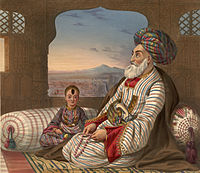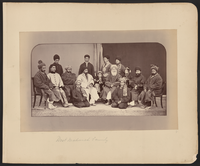Dost Mohammad Khan
| Dost Mohammad Khan دوست محمد خان | |||||
|---|---|---|---|---|---|
Emir of Afghanistan | |||||
| Reign | Summer 1826 – 2 August 1839 1843 – 9 June 1863 | ||||
| Predecessor | Sultan Mohammad Khan | ||||
| Successor | Wazir Akbar Khan Sher Ali Khan | ||||
| Born | 23 December 1792 Kandahar, Durrani Empire | ||||
| Died | 9 June 1863 (aged 70) Herat, Emirate of Afghanistan | ||||
| Burial | |||||
| Spouse | 16 wives[2] | ||||
| Issue | 27 sons and 25 daughters at the time of his death[3] | ||||
| |||||
| Dynasty | Barakzai dynasty | ||||
| Father | Sardar Payinda Khan Mohammadzai (Sarfraz Khan) | ||||
| Mother | Zainab Begum[4] | ||||
| Religion | Sunni Islam | ||||
| Military career | |||||
| Battles/wars |
| ||||
Emir Dost Mohammad Khan Barakzai (
At the beginning of his rule, the Afghans lost their former stronghold of
The Musahiban family started with his older brother, Sultan Mohammad Khan, nicknamed "Telai", meaning "golden", a nickname he was given because of his love of fine clothing.[11]
Background and rise to power
Dost Mohammad Khan was born to an influential
His elder brother, the chief of the Barakzai, Fateh Khan, took an important part in raising

From the commencement of his reign he found himself involved in disputes with
European influence in Afghanistan
At the intersection of British, Russian and, to a lesser degree, French imperial interests, political maneuvering was necessary. Rejecting overtures from Russia, he endeavoured to form an alliance with Great Britain, and welcomed Alexander Burnes to Kabul in 1837. Burnes, however, was unable to prevail on the governor-general, Lord Auckland, to respond to the Emir's advances. Dost Mohammad was enjoined to abandon the attempt to recover Peshawar, and to place his foreign policy under British guidance. He replied by renewing his relations with Russia, and in 1838 Lord Auckland set the British troops in motion against him.[21] To enable such an action, the British manufactured the evidence needed to justify the overthrow of the Afghan ruler.[22]
War with the Sikhs

In 1835, Dost Mohammad Khan, the youngest and the most energetic of the Barakzai brothers, who had supplanted the Durrani dynasty and become Emir (lord, chief or king) of Kabul in 1825, advanced up to Khaibar Pass threatening to recover Peshawar. In 1836, Hari Singh Nalwa, the Sikh general who along with Prince Nau Nihal Singh was guarding that frontier, built a chain of forts, including one at Jamrud at the eastern end of the Khyber Pass to defend the pass. Dost Muhammad erected a fort at `Ali Masjid at the other end. In the beginning of 1837, as Prince Nau Nihal Singh returned to Lahore to get married and the Maharaja and his court got busy with preparations for the wedding.[23]
Dost Muhammad Khan sent a 25,000 strong force, including a large number of local irregulars and equipped with 18 heavy guns, to invest Jamrud. The Sikh garrison there had only 600 men and a few light artillery pieces. The Afghans besieged the fort and cut off its water supply, while a detachment was sent to the neighbouring Sikh fort of Shabqadar to prevent any help from that direction. Mahan Singh Mirpuri, the garrison commander of Jamrud, kept the invaders at bay for four days and managed meanwhile to send a desperate appeal for help to Hari Singh Nalva at Peshawar. Nalva rose from his sick bed and rushed to Jamrud.[24]
The final battle was fought on 30 April 1837, the Afghans withdrew from battle after Hari Singh Nalva was killed. In 1838, with the help and agreement of the Sikh monarch who joined the Tripartite Treaty with British viceroy Lord Auckland, restored Shah Shuja to the Afghan throne in Kabul on 7 August 1839.[25][26] Dost Muhammad Khan was exiled by the British to Mussoorie in November 1840, but was restored to his former position after the murder of Shah Shuja in April 1842. He thereafter maintained cordial relations with the Lahore Darbar. These events led to the First Anglo-Afghan War.
Second reign
After the end of the First Anglo-Afghan War in 1842, Dost Mohammad Khan was now in a position to expand his state dramatically. This was in part due to the improving relationship between Dost Mohammad Khan and the British.[27][28][29] During his exile in Calcutta, he was treated warmly.
He took note of the technological superiority of the British and was convinced that constant wars with them would damage Afghanistan. Instead, Dost Mohammad would advocate for an alliance with the British as the only way to ensure the survival of the state.
In 1843, Dost Mohammad Khan subdued the
Conquest of the Balkh Wilayat
The invasion of Balkh was successful and the province was annexed into Afghanistan. When Afzal Khan would take materials from the dilapidated city of Balkh and use it to construct a cantonment known as Takhtapul nearby, so that by 1854 Takhtapul was a fully grown city complete with gardens and courts.[28][30][5] In 1850 Mohammad Akram Khan's half brother, Ghulam Haidar Khan, conquered Tashqurghan and the Mir Wali was forced to flee.[27]
Alliance with the British
On 30 March 1855, Dost Mohammad reversed his former policy by concluding an offensive and defensive alliance with the British government, signed by Sir
Conquest of Herat and Death
In March 1862,
Gallery
-
Khan with his one son.
-
Khan with his 3 sons.
-
Khan asEmir of Afghanistan.
-
Lithograph titled 'Dost Mahomed Khan and Part of His Family', by Emily Eden in 1841 (in Calcutta), published in 'Portraits of the Princes & People of India' in 1844
-
Dōst Moḥammad Khan seated slightly to the right of center in this photograph. To Dōst Moḥammad's right, the first figure in a white chapan (overcoat) is his son and successorAbd al-Raḥmān Khān(c. 1844 – 1901), the grandson of Dōst Mohammad and future "Iron Amir" of Afghanistan, is on Dōst Moḥammad's far left.
See also
- List of leaders of Afghanistan
References
- ISBN 978-1-4088-1830-5. Retrieved 15 June 2020.
- Encyclopedia Iranica. Retrieved 14 August 2021.
- ^ a b Tarzi, Amin H. "DŌSTMOḤAMMAD KHAN". Encyclopædia Iranica (Online ed.). United States: Columbia University.
- ^ "DŌST MOḤAMMAD KHAN". Iranonline. 15 December 1995. Retrieved 24 December 2020.
- ^ ISBN 978-90-04-23498-7.
- ISBN 1466222417.
- ISBN 978-90-04-15185-7.
- ^ Encyclopædia Britannica – Dost Mohammad Khan, "ruler of Afghanistan (1823–63) and founder of the Barakzay dynasty, who maintained Afghan independence during a time when the nation was a focus of political struggles between Great Britain and Russia..."
- ^ "Anglo-afghan wars", Encyclopaedia Iranica
- ^ Munshi.
- ISBN 978-0700706297. Retrieved 30 June 2016.
- ^ ISBN 978-0-8108-7624-8. Retrieved 3 April 2013.
- Mohan Lal, Volume 1. pp. 1–3.
- ^ "DŌST MOḤAMMAD KHAN – Encyclopaedia Iranica". iranicaonline.org. Archived from the original on 29 April 2011. Retrieved 22 February 2021.
Dōst Moḥammad Khan was raised by his Qezelbāš mother, from the Persian tribe of Sīāh Manṣūr and reportedly Pāyenda Khan's favorite wife, though not of noble stock.
- ^ Tarzi, Amin H. "DŌSTMOḤAMMAD KHAN". Encyclopædia Iranica (Online ed.). United States: Columbia University.
- ISBN 9780306818264
- ISBN 9780306818264
- ISBN 9781136603174.
- ^ Gupta, p. Topic 3 pp. 1391.
- ^ ISBN 978-1-351-69265-6.
- ^ a b One or more of the preceding sentences incorporates text from a publication now in the public domain: Chisholm, Hugh, ed. (1911). "Dost Mahommed Khan". Encyclopædia Britannica. Vol. 8 (11th ed.). Cambridge University Press. p. 438.
- ^ Munshi, p. 104.
- ^ Munshi, p. 105-106.
- ^ Munshi, p. 78.
- ^ Ranjit Singh Encyclopædia Britannica, Khushwant Singh (2015)
- ISBN 9781615302017.
- ^ ISBN 978-1-136-60317-4.
- ^ ISBN 978-90-04-10399-3.
- ^ ISBN 978-1-78914-010-1.
- Encyclopedia Iranica. Archivedfrom the original on 17 November 2018.
- ^ Stephen, Leslie, ed. (1889). . Dictionary of National Biography. Vol. 17. London: Smith, Elder & Co.
- ISBN 978-3-7001-7202-4.
- ^ a b Edward Balfour. The cyclopædia of India and of eastern and southern Asia. Bernard Quaritch, 1885
- ^ a b Mojtahed-Zadeh, Pirouz (1993). Evolution of Eastern Iranian boundaries: Role of the Khozeimeh Amirdom of Qaenat and Sistan (phd thesis). SOAS University of London.
Sources
- ISBN 978-1-408-82287-6.
- Noelle, Christine (1997). State and Tribe in Nineteenth-century Afghanistan: The Reign of Amir Dost Muhammad Khan (1826–1863) (illustrated ed.). ISBN 0-7007-0629-1.
- JSTOR 44252485.
- ISBN 0-631-19841-5.
- OCLC 967378175.
- Shahamat Ali (1970) The Sikhs and Afghans. Patiala,
- Harlan, Josiah (1842) A Memoir of India and Afghanistan, London.
- Burnes, Alexander (1843) Cabool, London.
- Ganda Singh (1959) Ahmad Shah Durrani, Bombay.
- Sun, Sohan Lal (1885–89) `Umdat-ut-Twarikh Lahore, (Online copy)
- Braithwaite, Rodric (2012) Afgantsy, London.





